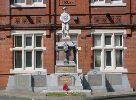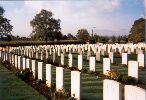
Newton-le-Willows and
Earlestown War Memorial

| OTHER WARS |
 |
Newton-le-Willows andEarlestown War Memorial |
 |
| The
Great War Roll of Honour |
|||||||||||||||||||||||||
Captain H. Whalley-Kelly, in his book “Ich Dien –
The Prince of Wales’s Volunteers”, gives the following account:
“On 16th June the Battalion took part in the assault of the Bellewaarde
Ridge from which the Germans were able to overlook the greater part of the ground
east of Ypres. The attack was carried out at dawn by the 7th and 9th Infantry
Brigades, and it was preceded by an intense bombardment. The first line of German
trenches was carried with little resistance but, unfortunately, the impetuosity
of the attackers could not be restrained and they ran into our own barrage before
it lifted, mist and smoke preventing the gunners observing what was happening.
This disorganised the attack, which was swept by accurate hostile fire from
three sides, and it degenerated into confused fighting with bombs and bayonets,
in which parties of the Battalion, which had been sent up to reinforce, took
a prominent part. At 9.30 a.m. the attackers, having no bombs left, fell back
to the German front line which was being held by a detachment of the Battalion.
Major Egerton Fairclough, calling to the men to follow him, immediately advanced,
however, and occupied part of the enemy’s second line trenches, south
of Bellewaarde Farm, before he could regain possession of them. All through
the day, despite severe shelling and a counter-attack at dusk, this gallant
party* hung on and prevented the enemy retaking this important locality. Meanwhile,
the remainder of the Battalion was still in its original assembly position,
where it suffered heavy casualties from hostile artillery fire, and “B”
Company, which was sent forward to reinforce the forward troops, was caught
by a concentration of high explosive and nearly wiped out. In the evening the
Battalion moved up to help in the consolidation of the new line, but it was
relieved at midnight.”
* Brigadier-General Sir James E. Edmonds in his account in “Military Operations
France and Belgium, 1915” (History of the Great War Based on Official
Documents)
states that this party withdrew at 3 p.m., but the evidence of the officers
present with the Battalion is unanimous that it remained in its forward position
until after dark.
This is the full account:
From Bellewaarde ridge, situated on the eastern side of the lake,
the enemy was able to overlook the greater part of the ground east of Ypres.
A minor operation was therefore planned .. to capture the ridge, which would
deprive the enemy of observation, and at the same time straighten out the re-entrant
in the British line between Hooge and Railway Wood.
Eight lines of jumping-off trenches, four behind the front trenches and four
behind the support line were dug; but, all the ground being under observation,
they were discovered and ranged on by the enemy, and to save the troops from
being heavily shelled whilst waiting for the assault it was decided to attack
at dawn.
The actual assault was entrusted to the 9th and 7th Brigades of the 3rd Division
… and formed up in four lines undiscovered by the enemy.
(1st Line, 9th Brigade: 4/Royal Fusiliers, 1/Royal Scots Fusiliers, and the
1/Northumberland Fusiliers, with the 1/Wiltshire (7th Brigade) to cover the
right of the attack;
2nd Line: 1/10th King’s (Liverpool Scottish) and 1/Lincolnshire.
3rd and 4th Lines, 7th Brigade: H.A.C. and 2/R. Irish Rifles; 3/Worcestershire
and 1/4th South Lancashire.)
The attack was divided into three stages: the first objective was the German
front line; the second, the line of the road from Hooge to Bellewaarde Farm;
and the final one the trench on the edge of the lake. After the first objective
had been taken by the 1st Line of the 9th Brigade, the 2nd Line was to go through
it and capture the second objective, the artillery lifting from the first objective
to the second at a fixed hour, but remaining on the second until ordered to
lift. The three battalions which took the first line were to reorganise there,
and eventually pass through the 2nd Line and capture the third objective, the
artillery conforming as before.
The bombardment was begun at 2.30 a.m. and continued, with pauses, until 4.15
a.m., when the artillery lifted, and the infantry assaulted and captured the
German front line with very little resistance, 157 prisoners being taken. But
as soon as the 2nd Line of the 9th Brigade, the Liverpool Scottish and Lincolnshire,
rose, the Royal Irish Rifles of the 7th Brigade, in the 3rd Line – who
were in reserve and not to advance unless ordered – could not be restrained
and rushed forward also, the H.A.C. in the trenches alongside them following
suit. The spirit which prompted the movement was excellent, but the result was
disastrous. The 3rd Line caught up the 2nd, which was waiting for the barrage
to lift, and so fast did the four battalions push on, that they ran into their
own artillery fire, mist and smoke preventing the gunners from seeing what was
happening. Upset by two battalions of the 7th brigade unexpectedly passing through
them, the Royal Fusiliers, Royal Scots Fusiliers and Northumberland Fusiliers
reorganising in the German front line preparatory to going through to the third
objective, advanced too soon. The trenches grew crowded with men, units got
mixed up, and it became almost impossible to organise or control the fight;
and to add to the confusion, German artillery fire, very heavy and accurate,
swept the battalions of the 3rd Division from three sides.
Nevertheless, the German second line was reached, and a party of the Royal Scots
Fusiliers actually got through to the final objective, only to be driven out
of it by their own artillery fire. A combat with bombs and bayonets in the network
of trenches now ensued and swayed backwards and forwards. About 7.30 a.m. the
enemy made a definite counter-attack, which was repulsed, and two further attempts
later in the day were broken up by fire; but at 9.30 a.m., being still under
very heavy shell fire and having no bombs left, the attackers fell back to the
first line of German trenches, with the exception of one of the parties of the
1/4th South Lancashire, used to reinforce, which hung on in trenches south of
Bellewaarde Farm till 3 p.m.
Eventually, at 6 p.m., it was decided to consolidate what had been previously
gained, the German front line for half a mile between the Menin road and Railway
Wood, and the area of No Man’s Land behind. The re-entrant had been slightly
reduced, the British line had been carried forward to just north of the Menin
road, but the enemy remained in possession of Bellewaarde ridge and the observation
posts on it.
The casualties of the 3rd Division had been 140 officers and 3,391 men, and
out of this total the 9th Brigade had lost 73 officers out of 96, and 2,012
men out of 3,663. The Germans lost 157 prisoners, and had some three hundred
other casualties.
(from “Military Operations France and Belgium, 1915” Vol II, compiled
by Brig.-Gen. Sir James E. Edmonds, published by the Imperial War Museum.)
Another account can be found here.